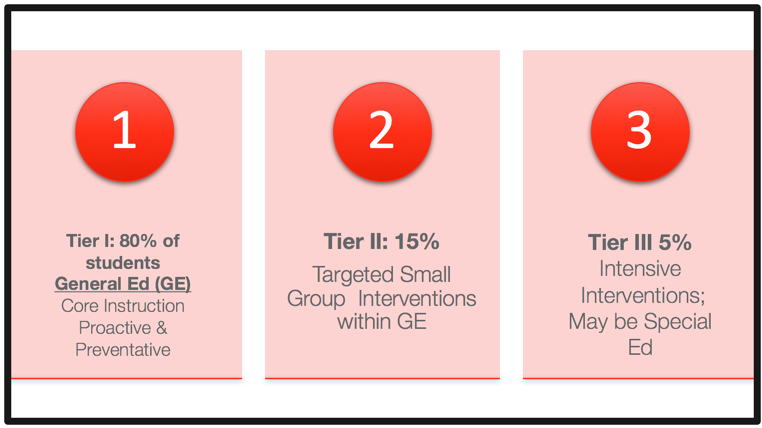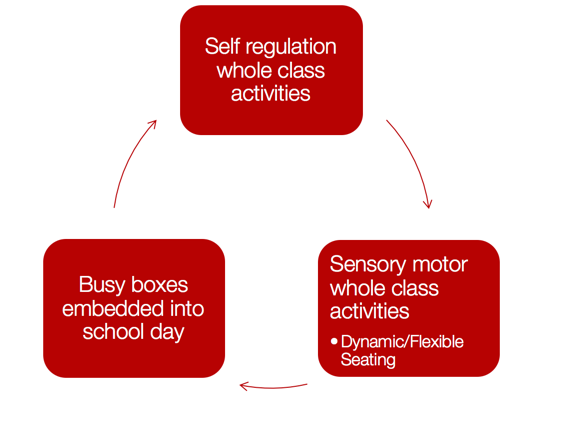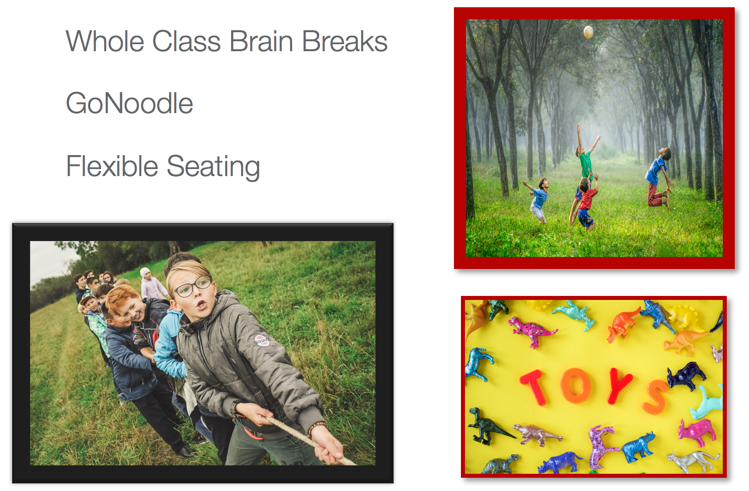Melanie: Hello everyone. I love how a webinar like this connects so many school-based practitioners and pediatric practitioners from all over the country and all over the world possibly. I have happily served pre-school and school-age children as a full-time school-based practitioner in South Central Pennsylvania for the past 20 years. As things have evolved with school-based practice, I have always been searching for good contemporary, evidence-based practice that I can use with the kids and teachers.
Overview
In the first part, we are going to talk about the historical trends of Response to Intervention (RtI) within a Multi-Tiered System of Supports framework. I want to discuss how to embed OT into elementary school via both of these frameworks. When I first started 20 years ago, no one had heard of this terminology. Now, 20 years later, this is a pretty hot topic. It is a great way to get more students access and exposure to OT services. Another objective for me today is to give you practical strategies and describe the benefits of using a RtI in an MTSS approach in your practice. I am a lifelong learner like many of you. My biggest wish for today is to give you all some practical strategies to take back to your schools. The last learning objective is for you all to recognize how to apply OT within the RtI/MTSS framework in schools. I think this is sometimes a challenge. The historical and legislative perspective will be really key as it is crucial to understand the laws and the funding that drive our services. We need to know how RtI gets funded within the school setting because it is a general ed approach. Many schools do not use it formally, but I want to give you some practical strategies to get your brain going.
Historical Perspective
- Current legislation mandates OT practitioners can support all learners, with or without disabilities, in their occupations as students.
- Under Part B of IDEA 2004…. as a related service
- Under NCLB… OT considered being a pupil service
- Every Student Succeeds Act (ESSA)…OT named as specialized instructional support personnel
In 2004, under Part B of IDEA, occupational therapy was defined as a related service. Under No Child Left Behind, we were defined as a pupil service. In the most current education law, Every Student Succeeds Act (ESSA), we fall under the category of specialized instructional support personnel. I think the most important thing to understand is that the mandate and the language are written in those laws. We, as practitioners, can support all learners with or without disabilities in their occupations as students. So, it is not a typical IEP crowd of kids that we are addressing. It could be a population-based approach that we are implementing.
Early Intervening Services= MTSS/RtI
These laws are designed for general education as well as special education. It is important to understand this because, from a federal perspective, this is where the funding comes in. I will talk more about this a little later in the webinar. You will want to look at your individual state practice acts to see how your state interprets that as not all states are on board with us providing RtI services. Luckily, they support this incentive in Pennsylvania. Under those laws, we are considered an early intervening service, or an EIS. The Multi-Tiered System of Supports/Response to Intervention falls under the EIS umbrella. We are supporting kids in general ed versus the typical special ed realms that we often work in. We are pushing into whole classrooms and offering our support.
So, MTSS and RTI are somewhat interchangeable. Depending on where you live locally, you may hear both terms or only one term. The MTSS umbrella is huge, it can include behavioral supports and things like that, but for our purposes, we are going to talk about traditional roles for OTs in schools.
Per AOTA (2016),
“OT practitioners provide services as a collaborative member of the team to students and on behalf of students through individual, group, whole classroom, and/or school-wide initiatives.”
Contemporary School-Based Practice
Everything should be anchored in evidence. This slide gives you another graphics or thematic about how OT fits in.

Figure 1. Schematic about OT in schools.
This is a contemporary school-based practice moving beyond the pullout model of one to one and embedding an OT practitioner into elementary. AOTA endorses this shift from a medical model, which again is more that one to one or small group pullout model, to a workload model in schools. My personal definition of clinical reasoning is found in the first box. It is focused on student-centered things and support from research. This is not just pulling research articles but a triangulation of those three factors.
The RtI Framework
Here is a slide that describes to you, just so you have a visual, of those tiers of Response to Intervention.

Figure 2. RtI tiers.
The first tier is going to be approximately 80% of your students in an elementary class. They are in general education and receiving all of the curricula that a regular ed student would get walking in the door. The Tier II kids are also in general education, but they are at risk. They may not be picking up their ABCs, their colors, and all the other concepts they are learning in kindergarten. I am going to keep referring to kindergarten as that is a big thrust for me and where I am at in practice. Tier II kids are in the middle. Tier III make up the last 5%. These are the children that are not responding to any general ed strategy. The team may start to look at some special education evaluations in these cases, including an occupational therapy evaluation.
OT Within RtI

Figure 3. OT within RtI.
In Tier 1, we can provide universal screenings to an entire classroom for fine motor issues as an example. That is an easy one. Looking at writing challenges, like copying from the board or a smart board, is another example of a population-based approach. We are collaborating with a teacher and looking at needs in a whole classroom. OT within Tier II of general education would be us targeting four or five students based on a teacher recommendation. You come up with specific strategies to embed within the classroom for these children. If we are part of a special education evaluation and then looking at developing some goals for the student to be implemented through the IEP process, this would be an example of Tier III.
Next, I am going to go over some examples of what I do in my school district. I have been pretty successful for the past six or seven years using these strategies.
Tier 1 OT Strategies
Initially, I was asked by a struggling school district to help with handwriting. I trained the entire district, which included 13 kindergarten teachers, on using the Handwriting Without Tears curriculum. I am not specifically endorsing that program in this talk, but that was the curriculum I had used the most. It is multi-sensory, and there is a lot of evidence behind it.
Tier 1 Crayon Club
- Permission from School Administrators
- OT/Kindergarten Teacher Collaboration
- Develop Content of 4 Whole Class Lessons with Teachers
- Fall Letter to all Kindergarten Parents/Guardians
- Schedule Four 30 Minute Class Lessons with each Kindergarten Teacher
- Collect Data via Student Work Samples/Observation
Now that the teachers were trained, we could now bring this program into the classrooms. It is important to get permission from administration before undertaking a program-wide intervention like this. The teachers and I developed this content for the classrooms in the fall. We sent out a letter in the fall for all Kindergarten parents and guardians. After we did the four class lessons in the fall, then we moved into more Tier II strategies in the spring, which I will get into a little bit later. There is a PDF in the handouts that go over this model more. The schedule was four class lessons that were rotated through seven different classrooms. The lessons were typically 30 minutes. In the first 15 minutes, I incorporated music and singing from the Handwriting Without Tears program. The second part of the class was working on worksheets, and then I collected that data.
Additional Tier I Strategies
Here are some additional Tier I strategies beyond embedding a curriculum into kindergarten for writing (Figure 4).

Figure 4. Other Tier 1 strategies.
Some activities include self-regulation, whole class sensory-motor activities, and busy boxes. Sensory-motor activities could include whole class brain breaks. The GoNoodle website has some great resources. Dynamic/flexible seating are other options to try. These seating options include wedge cushions and wobble seats and stools. There is great research out there on both movement and learning for both special ed and general ed.
Here are some examples of busy boxes in Figure 5.

Figure 5. Busy boxes.
The busy boxes change depending on the age level. I have a teacher that has 24 kids and 24 busy boxes in her first-grade class. They are along the wall and labeled with numbers like one through 24. When they arrive in the morning, they get their busy boxes and work on them for the first 10-15 minutes. These busy boxes support the building of foundational fine motor skills in the general ed population. Teachers and I consult on the contents of the busy boxes. I get many of my ideas on Pinterest. I love Jenga (middle picture), and I often use it. It works on hand manipulation, visual and eye-hand coordination, visual perception, and all those skills that kids need in their occupations.
Figure 6 shows more ideas.

Figure 6. Other busy box ideas.
Here are some brain break ideas.
- Episodic small groups for struggling students
- Could include motor, social, and self-regulation activities
- “Pencil Pals”
Kids are not built developmentally to sit in chairs all day. Teachers are starting to recognize that. A couple breaks in the morning, lunchtime, and recess can be really helpful. As I mentioned earlier, GoNoodle is a great resource.
Tier II OT Strategies
- Episodic small groups for struggling students
- Could include motor, social, and self-regulation activities
- “Pencil Pals”
After we did our whole class lessons with these kids in the fall, we looked for any children that needed extra attention. This could include social and self-regulation activities for the pocket of two or three kids in each general ed class.

Figure 7. Examples of activities for smaller groups.
Tier 2- KDG Pencil Pals Model
One group was the "Pencil Pals." This is the next strategy after Tier I.
- Post Crayon Club Fall Whole Class Lessons
- Request each Kindergarten teacher identify 2 students who continue to have challenges with printing/fine-motor class participation (typically in January/February)
- These Students DO NOT have an IEP
- Parent Letter Home to Targeted Students
- Develop Content of Pencil Pals with Kdg Teachers
- Schedule Five 30 Minute Small Groups
- Collect Data via Work Samples/Observation
- Document Participation in Student’s Cum Folder
After Crayon Club, I go back to the teachers and asked them to identify some students to participate in this next group. Invariably, one teacher will have no kids, while another teacher will have four kids. It usually evens out over six or seven classrooms. I usually have about 12 or 13 kids identified. These kids do not have an IEP but just need support within the general ed population. I send a letter home, just like Crayon Club. This is only to about 12 kids out of the entire population. I work through content with the teachers and typically schedule activities for five to six weeks. It depends on the teachers and their schedule in the spring and what they want. It is centered around their concerns or their needs. I collect data via whatever the kids produce during the groups. I also use worksheets from the Handwriting Without Tears curriculum with this group. However, if you prefer something different, that is fine to use as well. I document their participation so as they move on to first grade, everyone can see what they have been working on. Now, I am drilling down to about 10 kids from a total of 120.
Additional Tier II Strategies
There are some other additional strategies to use at this level.
- Modified classroom seating
- Assistive technology, no tech to high tech
- Portable keyboarding/touchscreen devices
Tier III Strategies
Now, we are going to talk about student-centered occupation-based evaluations and direct OT services for individual students (Figure 8).

Figure 8. Tier III strategies.
We are now treating students on a 504 plan, or most likely an IEP. There are also other team members involved with this process.
Important RtI Points
- Embedding OT into elementary via RTI typically decreases unnecessary referrals for OT screens & evaluations
- Allows OTs to support more students & teachers via a population-based approach
- Students may move freely between tiers
For me personally, this has decreased unnecessary kindergarten and first-grade level referrals because I am in communication with the teachers on a regular basis. It is embedded in the whole process. It could be the kid that just needs a little extra time to form letters or some extra developmental time. We all know kindergarten is kind of the new first grade. By implementing these strategies and embedding myself this way in general ed, it has made the process smoother. It has allowed me to support more students and teachers through this RtI/MTSS framework. A last important point is that kids move between the tiers. For example, you may have a kid in Tier II in your small group lessons, but if there are still concerns ongoing, they may be moved into Tier III.
OT and RtI Evidence
- Dr. Denise Donica study Published in AJOT 2015
- Handwriting Without Tears®: General education effectiveness through a consultative approach
- Explored the effectiveness of the HWT Kindergarten printing curriculum in GE via consultative approach with OT
Dr. Denise Donica published an AJOT study in December 2015. It is very similar to my Crayon Club. This was exciting to see her work that is supported and rooted in evidence. She consulted with teachers using the Handwriting Without Tears curriculum. They explored the effectiveness of using that and were able to prove handwriting skills improved after the Handwriting Without Tears curriculum. Dr. Donica is from East Carolina University is very wonderful and approachable. I reached out to her about this webinar, and she is generating a lot of research on this topic right now. She has some more studies coming out in AJOT in the coming months and years. Keep a look out for these.
What is the significance to us as OT practitioners? It is expanding our roles beyond just that traditional direct service pullout model, which also kind of aligns with AOTA's endorsement of workload and caseload (Figure 9).

Figure 9. Expanding our roles.
It is always good to mention the law and the legal pieces of this. You want to make sure that state to state that you fall in line with your practice act.
